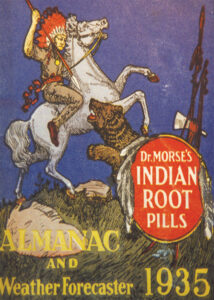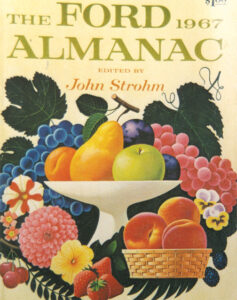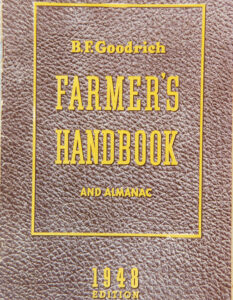 By Robert Reed
By Robert Reed People would probably guess that Benjamin Franklin’s Poor Richard’s Almanac is one of the most prized of historic almanacs in the country. And they would be right. A 1749 issue recently brought $3,000 at a leading auction gallery.
However a great many advertising almanacs are still out there – if not undiscovered at least at relatively reasonable prices.
Almanacs offer a faded glory. Part of their appeal is the fact that they have come and gone on the American scene. With all due respect to the Old Farmer’s Almanac and a few others, the almanac is no longer a part of the culture of this country. While more of us can read than ever before, we no longer thumb through the almanac for advise on weather, health, cooking, or when to plant winter peas.
There is no denying their impact however. Spanning over 350 years, as many as 7,000 different almanacs were consumed and saved by Americans. Today they are collected by generations far removed from their proud past. They are now being saved for their content, design, and advertising sponsors.
Most accounts say the first almanac printed in this country was published by William Pierce Mariner in 1639. Scores of similar publications followed offering general information and even astrological and weather data for a particular year. Early almanacs provided a listing of moon phases for planting and harvesting crops, gave social advice, and became one of the few sources of reference on home health care. The Boston Almanac of 1692 carried an announcement for some super tonic said to cure any number of things including “distemper of the dry bell ach….” Other equally questionable tonic cures were also noted in the New-England Almanac of 1696.
After a stay in prison for his publishing activities in Boston, James Franklin took his operation to Newport, Rhode Island where he published Franklin’s Rhode-Island Almanac starting with the year 1728. Other publications of that grand era included Bowen’s New England Diary, Poor Job’s Almanac, Bickerstaff’s Boston Almanac, and Ben Franklin’s famed Poor Richard’s Almanac. Franklin used the pseudonym of Richard Sanders in those times, and thus the now famous title of Poor Richard.
 From 1733 to 1748 the Poor Richard Almanac was published by Franklin directly and more the imprint B. Franklin. After 1748 the imprint was B. Franklin and D. Hall, as a partnership was formed. Still later issues of the Poor Richard Almanacs were identified as from Hall and Sellers.
From 1733 to 1748 the Poor Richard Almanac was published by Franklin directly and more the imprint B. Franklin. After 1748 the imprint was B. Franklin and D. Hall, as a partnership was formed. Still later issues of the Poor Richard Almanacs were identified as from Hall and Sellers.Toward the end of the 18th century almanacs were appearing more and more often, almost any city of any size that was served by an ambitious printer. In Connecticut, for example, there were almanacs published in at least three different cities between 1783 and 1800–Norwich, New London, and Hartford. Meanwhile in Philadelphia, Bailey’s Pocket Almanac printed in 1786 included maps of proposed western states including Michigan, Illinois, Assenisipia, Sylvania, and Polypotamia.
There was a flood of almanacs in America during the 19th century. Readers could select form such titles as the Hard Cider and Long Cabin Almanac, the Rough and Ready Almanac, the Piratical & Tragical Almanac, The Brethern Family Almanac, and even the General Taylor Almanac. Many supported political or social causes and used their title and many pages to promote their intended goal.
DeSilver’s Almanac of 1831 listed Civil and Military officials of the United States, Masonic information, advice to mothers, and an account of the most extraordinary cases ever recorded in the annals of medicine. The 1840 American Anti-Slavery Almanac was “calculated for New York, and adapted to the northern and middle states.”
“Almost everyone, especially readers whose livelihood came from the sea or from farming, respected the almanacs’ weather records and data,” confirms the able Family Encyclopedia of American History. “But most of the wisdom actually centered on subjects like health, household hints, and recipes.”
Still the major trend for almanacs during the second half of the 19th century was purely commercial. Some bore outlandish scientific beliefs, and offered wild medical claims. Manufacturers, especially those dealing in patent medicines, began to see advertising potential in such ‘must read’ almanacs and local merchants were encouraged to give them away to customers at little or no charge. At this point almanac choices reached from the likes of the August Flower and German Syrup Almanac to Morse’s Indian Root Pill Almanac. By 1890 millions of patent medicine almanacs were being distributed every year to a semi-rural population that dearly loved them. For many of these families, a handed-out almanac was the only book they could afford.
 Advertising played a dominate role in almanacs early into the 20th century as a majority were either published by those with goods or services to sell directly, or published by those with a general audience and again made available though local merchants. Titles like Rawleigh Products Almanac, Watkins’ Home Doctor and Cook Book Almanac, Studebaker’s Farmer’s Almanac, and Hill’s Southern Almanac were distributed to an eager public.
Advertising played a dominate role in almanacs early into the 20th century as a majority were either published by those with goods or services to sell directly, or published by those with a general audience and again made available though local merchants. Titles like Rawleigh Products Almanac, Watkins’ Home Doctor and Cook Book Almanac, Studebaker’s Farmer’s Almanac, and Hill’s Southern Almanac were distributed to an eager public.Even in the 1930s and 1940s sources for almanacs remained somewhat diverse extending from F.S. Royster Guano Company and B. F. Goodrich to the folksy almanac premium from the Lum and Abner radio show and Kellogg’s Housewife Almanac Yearbook. During the 1950s as Americans spent greater time with television and other more immediate sources of information, the number and variety of almanacs dwindled considerably.
While cherished issues of Poor Richard’s Almanac and the Wilmington Almanac are not likely to be found outside of major auction galleries or the inventory of leading dealers, others can be readily found. Almanacs without important historical connections, even fairly old ones, can still be found in the marketplace.
Those almanacs which tout political and social causes, i.e. anti-slavery, anti-Masonic, are probably the second most collectible category of American almanacs. Prices on these issues have appreciated significantly in recent years.
Finally, almanacs with colorful and interesting (if not entirely truthful) advertising as their main thrust remain relatively inexpensive. As interest grows in this country’s advertising past, particularly advertising paper, fine examples of this type will be more in demand.















Follow Us